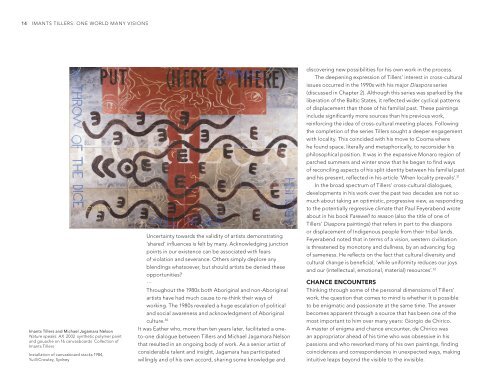introduction: a work in progress - National Gallery of Australia
introduction: a work in progress - National Gallery of Australia
introduction: a work in progress - National Gallery of Australia
Create successful ePaper yourself
Turn your PDF publications into a flip-book with our unique Google optimized e-Paper software.
14 IMANTS TILLERS: ONE WORLD MANY VISIONS<br />
Imants Tillers and Michael Jagamara Nelson<br />
Nature speaks: AX 2002 synthetic polymer pa<strong>in</strong>t<br />
and gouache on 16 canvasboards Collection <strong>of</strong><br />
Imants Tillers<br />
Installation <strong>of</strong> canvasboard stacks 1984,<br />
Yuill/Crowley, Sydney<br />
Uncerta<strong>in</strong>ty towards the validity <strong>of</strong> artists demonstrat<strong>in</strong>g<br />
‘shared’ <strong>in</strong>fluences is felt by many. Acknowledg<strong>in</strong>g junction<br />
po<strong>in</strong>ts <strong>in</strong> our existence can be associated with fears<br />
<strong>of</strong> violation and severance. Others simply deplore any<br />
blend<strong>in</strong>gs whatsoever, but should artists be denied these<br />
opportunities?<br />
…<br />
Throughout the 1980s both Aborig<strong>in</strong>al and non-Aborig<strong>in</strong>al<br />
artists have had much cause to re-th<strong>in</strong>k their ways <strong>of</strong><br />
<strong>work</strong><strong>in</strong>g. The 1980s revealed a huge escalation <strong>of</strong> political<br />
and social awareness and acknowledgment <strong>of</strong> Aborig<strong>in</strong>al<br />
culture. 30<br />
It was Eather who, more than ten years later, facilitated a oneto-one<br />
dialogue between Tillers and Michael Jagamara Nelson<br />
that resulted <strong>in</strong> an ongo<strong>in</strong>g body <strong>of</strong> <strong>work</strong>. As a senior artist <strong>of</strong><br />
considerable talent and <strong>in</strong>sight, Jagamara has participated<br />
will<strong>in</strong>gly and <strong>of</strong> his own accord, shar<strong>in</strong>g some knowledge and<br />
discover<strong>in</strong>g new possibilities for his own <strong>work</strong> <strong>in</strong> the process.<br />
The deepen<strong>in</strong>g expression <strong>of</strong> Tillers’ <strong>in</strong>terest <strong>in</strong> cross-cultural<br />
issues occurred <strong>in</strong> the 1990s with his major Diaspora series<br />
(discussed <strong>in</strong> Chapter 2). Although this series was sparked by the<br />
liberation <strong>of</strong> the Baltic States, it reflected wider cyclical patterns<br />
<strong>of</strong> displacement than those <strong>of</strong> his familial past. These pa<strong>in</strong>t<strong>in</strong>gs<br />
<strong>in</strong>clude significantly more sources than his previous <strong>work</strong>,<br />
re<strong>in</strong>forc<strong>in</strong>g the idea <strong>of</strong> cross-cultural meet<strong>in</strong>g places. Follow<strong>in</strong>g<br />
the completion <strong>of</strong> the series Tillers sought a deeper engagement<br />
with locality. This co<strong>in</strong>cided with his move to Cooma where<br />
he found space, literally and metaphorically, to reconsider his<br />
philosophical position. It was <strong>in</strong> the expansive Monaro region <strong>of</strong><br />
parched summers and w<strong>in</strong>ter snow that he began to f<strong>in</strong>d ways<br />
<strong>of</strong> reconcil<strong>in</strong>g aspects <strong>of</strong> his split identity between his familial past<br />
and his present, reflected <strong>in</strong> his article ‘When locality prevails’. 31<br />
In the broad spectrum <strong>of</strong> Tillers’ cross-cultural dialogues,<br />
developments <strong>in</strong> his <strong>work</strong> over the past two decades are not so<br />
much about tak<strong>in</strong>g an optimistic, <strong>progress</strong>ive view, as respond<strong>in</strong>g<br />
to the potentially regressive climate that Paul Feyerabend wrote<br />
about <strong>in</strong> his book Farewell to reason (also the title <strong>of</strong> one <strong>of</strong><br />
Tillers’ Diaspora pa<strong>in</strong>t<strong>in</strong>gs) that refers <strong>in</strong> part to the diaspora<br />
or displacement <strong>of</strong> Indigenous people from their tribal lands.<br />
Feyerabend noted that <strong>in</strong> terms <strong>of</strong> a vision, western civilisation<br />
is threatened by monotony and dullness, by an advanc<strong>in</strong>g fog<br />
<strong>of</strong> sameness. He reflects on the fact that cultural diversity and<br />
cultural change is beneficial, ‘while uniformity reduces our joys<br />
and our (<strong>in</strong>tellectual, emotional, material) resources’. 32<br />
CHANCE ENCOUNTERS<br />
Th<strong>in</strong>k<strong>in</strong>g through some <strong>of</strong> the personal dimensions <strong>of</strong> Tillers’<br />
<strong>work</strong>, the question that comes to m<strong>in</strong>d is whether it is possible<br />
to be enigmatic and passionate at the same time. The answer<br />
becomes apparent through a source that has been one <strong>of</strong> the<br />
most important to him over many years: Giorgio de Chirico.<br />
A master <strong>of</strong> enigma and chance encounter, de Chirico was<br />
an appropriator ahead <strong>of</strong> his time who was obsessive <strong>in</strong> his<br />
passions and who re<strong>work</strong>ed many <strong>of</strong> his own pa<strong>in</strong>t<strong>in</strong>gs, f<strong>in</strong>d<strong>in</strong>g<br />
co<strong>in</strong>cidences and correspondences <strong>in</strong> unexpected ways, mak<strong>in</strong>g<br />
<strong>in</strong>tuitive leaps beyond the visible to the <strong>in</strong>visible.

















